As the intoxicating notes of a jazz standard flowed effortlessly from the guitar at a 1950s nightclub, the audience was held captive; not just by the music, but by the unusual guitar being strummed. They were witnessing a revolution right on that stage – a beautiful design married to rich tones that carried a musical promise. A guitar that would jolt the music world – the Gibson Byrdland.
Musicians and enthusiasts alike often ask, what is it about this guitar that makes it stand apart? Is it its slender, sleek profile? Or the thrusting sound it generates? The story of this sublime instrument is steeped in jazz and rock ‘n roll history, in technical innovation, and in the thrill of musicianship.
I’m Robert Williams, your tour guide for this deep dive. As a guitar journalist with a penchant for detail, I’ve spent years exploring the ins and outs of iconic instruments. The Gibson Byrdland, an articulation of sheer elegance and potent musicality, stands out. This examination into the Byrdland is driven by my fascination and drawn from my in-depth knowledge and experience. Now, let’s tune in and explore the legacy, construction, and sheer charisma of the Gibson Byrdland guitar.
History of the Gibson Byrdland
Byrdland’s Creation and Influence
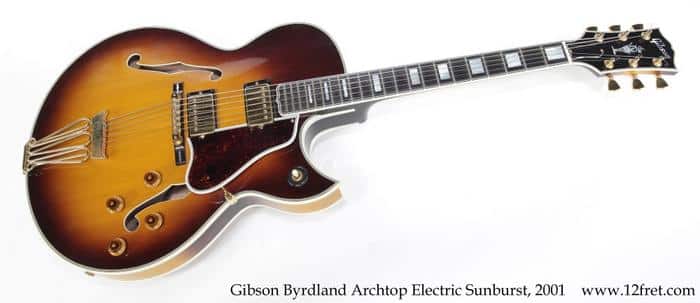
I’ve always admired the profound influence of Billy Byrd and Hank Garland on guitar music, especially as they inspired the creation of Byrdland. Truly, their impact is an intricate chapter of the History of the Gibson Byrdland story. Born from the genius collaboration between these iconic jazz guitarists and Gibson, Byrdland came to life in the year 1955 as a pioneering short scale, hollow body guitar model.
Carved from such an avant-garde partnership, it’s no surprise that Byrdland introduced unique features that were revolutionary for its time. Byrd and Garland envisaged an instrument that enhanced mobility across frets, especially in the higher registers – a feature that evidently bridges the gap between the electrifying energy of rock and roll and the intricate virtuosity of jazz.
The influence of Byrdland extends beyond its technical offerings. It shaped the sound profiles of numerous artists in varied genres. It’s a testimony to the versatility of its design and relevance in music history. The creation of Byrdland is indeed a turning point in guitar evolution, imparting profound influence on subsequent models.
As we delve into the finer details of the guitar’s unique characteristics and its comparison with other models, our exploration of the Gibson Byrdland continues to unfold. Indeed, understanding Byrdland’s creation and influence is a foundational pillar in truly appreciating the musical magic of this timeless instrument.
The Advancement of Byrdland Models
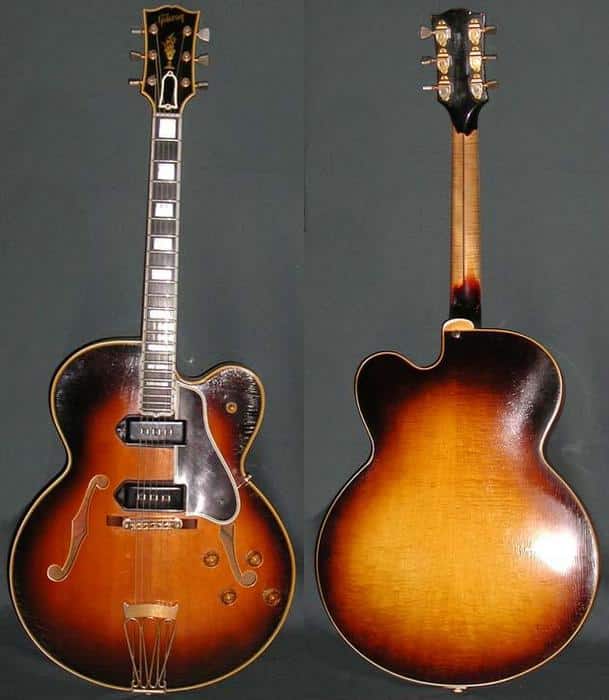
Continuing from the Genesis of the Gibson Byrdland, its trajectory into the realm of legendary guitars was shaped by the periodic enhancements encapsulated by the successive Byrdland models. This journey of fine-tuning and innovation is equally fascinating and integral to understanding the Byrdland’s enduring charisma.
During the late 1950s, Byrdland models moved away from the traditional rounded Venetian cutaway towards a pointed Florentine design. This evolution was boldly daring, emphasizing Byrdland’s commitment to unceasing transformation that kept it in sync with the evolving tastes of musicians.
As the decades progressed, Byrdland introduced upgrades like thin top and back construction, rendering the instrument more responsive and resonant. The 1960s marked a paradigm shift, with the advent of the humbucking pickup, a feature that effectively reduced hum, thus providing a cleaner sound. This truly cemented Byrdland’s position as a guitar that did not rest on past laurels, but continually strived to set a higher benchmark.
Such instrumental advancements have indelibly marked the history of the Gibson Byrdland. Each modification, each refinement, shows a guitar model that lives and breathes with its players, adapting and re-inventing itself in tandem with the pace of musical progression. It is this relentless pursuit of excellence that underlines the relevance and enduring allure of Byrdland.
As we venture further, the intricate details of Byrdland’s features and specifications come into the spotlight, further illuminating how these enriched the playing experience.
Features and Specifications of Gibson Byrdland
Unique Byrdland Characteristics

In diving deeper into the features and specifications of the Gibson Byrdland, one cannot overlook its distinct properties that shape its character. Foremost amongst these unique Byrdland characteristics are its PAF humbuckers. Laden with the legendary Patent Applied For pickups, they play a pivotal role in crafting the Byrdland’s signature sound. The PAFs give those mellow, rich tones that set this guitar apart and make it sought after in the music industry. It’s worth noting that these humbuckers contribute greatly to Byrdland’s distinct sonic personality, producing smooth and textured sounds that resonate brilliantly in various musical genres.
Moving from its sound to its physical edge, the short scale of the Gibson Byrdland rings another unique bell. At 23.5 inches, the Byrdland displays a shorter scale than most archtop guitars. This shorter scale, uncommon in standard Gibson models, contributes significantly to playability. It facilitates complex chords and fast runs, affording musicians notable dexterity, thereby easing speed of performance. Such a thoughtful application of design indeed ensures an unparalleled playing experience.
It is these ‘unique Byrdland characteristics’ that not only contribute to its reputation and popularity but also sustain the flamboyance of its legacy. They make the Gibson Byrdland a standout in its class and a fascinating subject for comprehensive examination and discussion within our broader guitar analysis.
Detailed Byrdland Specifications
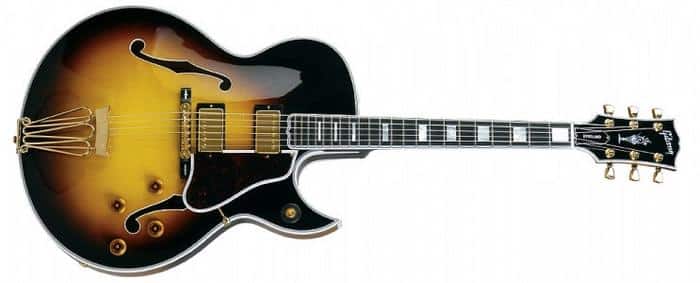
Blend with the fluid rhythm of our topic’s unfolding narrative, I can’t help but dive deeper into the exceptional details that catch my trained eye. Here’s where my role as an editor and music transcriber really comes into play. Teasing out the finer aspects of the Byrdland has always been a yearning; a sweet spot where my meticulous eye for detail and my unabating passion for music effortlessly merges.
Gibson’s Byrdland, its very identity is derived from an ensemble of expertly crafted specifications. A distinct spruce top with a beautifully figured maple back and sides, set off the overall architecture. The ultra-thin neck, tapering out into the standard width at the nut, provides players with a unique feel and far-reaching access to upper frets, igniting creativity at every turn.
At the heart of Byrdland, we find Gibson’s 57 Classic Humbuckers. These pickups, producing a tone that’s simultaneously vintage and modern, whispers in the realm of sublime perfection. The variety of sounds you can create, be it a brassy, cutting tone, or a warm, silky one, underscores Byrdland’s integral versatility.
A rainbow of four dazzling finishes—natural, sunburst, burgundy and ebony— each leaves a stain of richness, stamping its uniqueness on each handmade piece. Thus, Byrdland’s myriad of specifications contribute to its legendary reputation among guitar establishments.
Having sharpened the details of these detailed specifications, let’s compare the quintessential Byrdland to other market contenders. This tour-de-force will give you a better understanding of its position among other high-end instruments and will further solidify your understanding of it’s worth in the collectability and value realms.
Comparison: Gibson Byrdland vs. Other Models
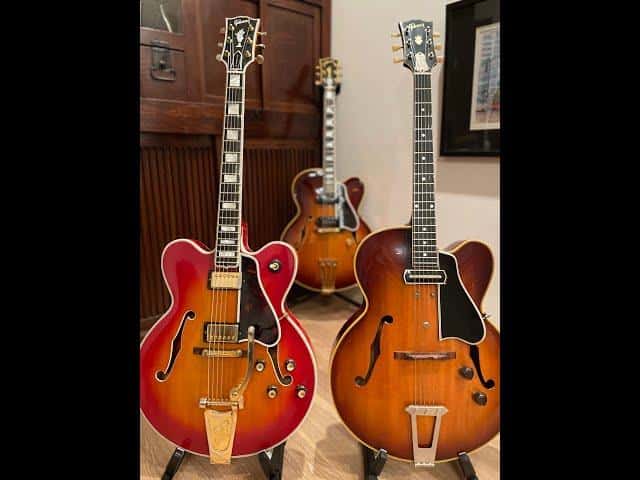
As we delve into the subject of our discussion, it’s vital to remember that no guitar exists in isolation. Every model has its unique qualities, and through comparisons, we appreciate these nuances better. So, how does the Gibson Byrdland compare to other iconic guitar models? The answer to this question isn’t as straightforward as you might think.
A large part of my work involves comparing different guitar models, and over the years, I’ve developed an intimate understanding of what each brings to the table. My in-depth knowledge from examining various models will shed light on how Byrdland fares against other renowned models.
So, let’s take a step back from the Gibson Byrdland for a moment and consider other popular models. The Gibson ES-175, for instance, is another time-honoured guitar renowned for its playability and tonal versatility. While the Byrdland and ES-175 may share a brand and hollow body heritage, they diverge significantly in their construction and suited genres.
The ES-175’s 24.75-inch scale length—longer than Byrdland’s unique 23.5 inches—affects the strings’ tension and, by extension, the guitar’s feel and sound. It makes the guitar more suited to blues and rock, giving it more “bite.” By contrast, the Byrdland, with its shorter scale, excels at jazz and fingerstyle, providing smoother playability. The craftsmanship in the Byrdland model is also distinctly more refined, exuding a certain superiority over the ES-175 in finish and detailing.
Comparatively, another Gibson model, the L-5, is famous for its full-bodied, loud acoustic sound, a sharp contrast to the softer-toned Byrdland. While the Byrdland was in part an evolution of the L-5, it was deliberately designed to offer greater responsiveness and faster play. Although both models are greatly valued by jazz and fusion players, they cater to contrasting tonal tastes within these genres.
Moving beyond Gibson, consider Fender’s Stratocaster, another legendary model. The Strat is famous for its brighter, chime-like tone, very different from the warm, mellow tonality of the Byrdland. Additionally, with its solid body, the Strat delivers a sustain that the hollow-body Byrdland cannot match.
Of course, each of these guitars has its strengths, and the choice ultimately comes down to personal preference and the type of music one wishes to create. In my assessments, though, the Gibson Byrdland consistently holds its own against these models, with its unique selling points ranging from its shorter scale length and exquisite craftsmanship to its versatile tone and esteemed heritage.
This comparison has only scratched the surface. Still, it should provide some insight into the unique place the Gibson Byrdland holds in the pantheon of iconic guitars. However, there’s more to this exquisite guitar than specs and comparisons, so read on to learn about the famous players who have favoured the Byrdland over the years and what makes it such a valued collector’s piece.
Byrdland Guitar Players and Reviews
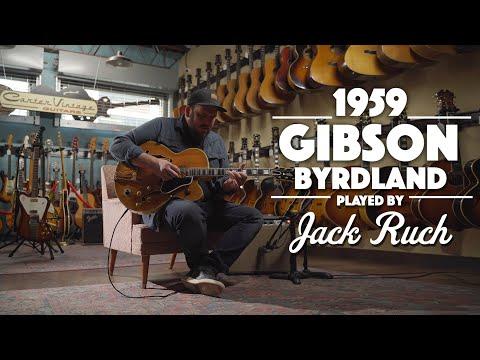
In my journey as a prominent figure in the realm of guitar journalism, I’ve had the privilege of crossing paths with some of the most admirable musicians. This exposure has provided me the unique opportunity to delve beyond the surface into the realm of Gibson Byrdland guitar players. It’s not just about who has held this famed instrument; it also extends to the invaluable insights they’ve shared with me, rendering a detailed, inside perspective on this illustrious guitar.
Would you like to know who among the greats have played the Byrdland, and what they think about this legendary guitar? Allow me a moment to illuminate this chapter of the guitar’s legacy.
Over time, the Gibson Byrdland has been in the hands of an impressive array of musicians, from Jazz to Rock, transcending a diverse array of musical styles. Its inventors, Billy Byrd and Hank Garland, were the foremost advocates, of course. Two of the most celebrated Jazz musicians of their time, they adored this model for its versatile functionality, responsive playability, and enthralling tonal quality that complimented their artistry.
Then there’s Ted Nugent, the rock guitarist renowned across the globe. Nugent’s fondness for the Gibson Byrdland is widely recognized, his enthusiastic application of it fuelled his career, shaping his distinctive sound. His Byrdland of choice resonated with a fat yet perfectly controlled tone, a tribute to the guitar’s remarkable balance of depth and clarity.
The late, revered jazz guitarist Jim Hall, on the other hand, marvelled at the Byrdland’s tonal versatility and effortless playability. He found it to be rich in harmonics and truly responsive, a model that allowed him to articulate his distinctive style with ease and precision.
Simply put, the Gibson Byrdland has won the hearts of diverse musicians, its time-tested trail marked by respect and admiration. The insights I’ve gathered have reinforced the universal consensus: the Byrdland, with its unique characteristics, detailed specifications, and spectacular advancement over the years, stands unrivalled in terms of craftsmanship and performance.
As we transition to discussing the guitar’s collectability and value, remember that the instrument’s esteem is not just a product of its impressive features or storied history. Rather, it is the combined sum of the talented musicians who, over generations, have adopted, played, and endorsed the Byrdland. They are a testament to the guitar’s enduring legacy and continuing appeal.
Collectability and Value of Gibson Byrdland
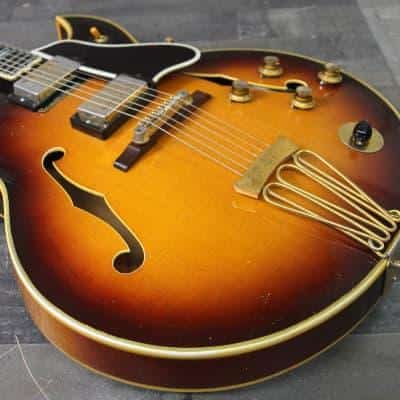
From my vast experience in guitar journalism, the thrill of identifying hidden gems among musical instruments never wanes. Together, we will explore a true masterpiece among them, the Gibson Byrdland, a guitar with a unique collectability factor that surpasses its stunning looks and impressive sonic capabilities.
This begs us to ask: What makes the Gibson Byrdland a treasure among collectibles, and how much is it worth in today’s market?
Ever since Gibson introduced Byrdland in 1955, it has gained an iconic status within the music industry, coveted by guitar enthusiasts and collectors worldwide. This attraction stems from its rarified genesis, which is intrinsically interwoven in the history of Gibson itself, and the celebrities who have wielded it.
But what makes it shine brighter than most is that it was never produced in large quantities, and those models aged with grace. The blend of rarity and aesthetic endurance render the Gibson Byrdland the equivalent of a ’56 Fender Stratocaster or a ’59 Les Paul in terms of collectability. It is an elusive prize, highly sought after within the guitar ecosystem.
Notably, given its consistent allure and rarity, the Byrdland’s value in the current market remains high. The original models can fetch up to $10,000, with prices varying based on condition and vintage. The reissue versions from Gibson’s custom shop also maintain their value, commonly selling in the $4,000 to $5,000 range.
However, purchasing a Byrdland is not only an investment for financial gain. Owning this iconic model is a ticket to a grand history—a vibrant journey through music’s golden era, etched in the soul of a piece of art like no other. It is an experience that transcends its monetary worth, enveloping you in historical significance, and serenading you with musical power. It brings a personal connection that resonates with the love and respect for musical craftsmanship every time you strum the strings.
In the subsequent chapters, we will delve deeper into the details, comparisons, unique characteristics, and why the Gibson Byrdland holds its majesty among other models, further cementing its collectability and value in Gibson’s grand legacy.
FAQs
What is the Gibson Byrdland Guitar?
The Gibson Byrdland is an electric guitar model first manufactured by Gibson in 1955. This hollowbody guitar was named after its first users, Billy Byrd and Hank Garland – two prominent Nashville session musicians. Its key features include a single-cutaway body and a shorter scale length, that made complex chord voicings more accessible.
What makes this guitar unique?
The Gibson Byrdland stands out due to its thin, hollow body design, and a shorter scale length of 23.5-inch, compared to the regular 25.5-inch scale. The guitar was designed this way to cater to musicians who desired a faster, more comfortable playing experience. Furthermore, its distinctive Venetian cutaway adds to its unique aesthetic appeal.
What type of music is the Gibson Byrdland best suited for?
Originally, the Gibson Byrdland was designed with jazz, country, and pop musicians in mind – genres that require complex chord positions. However, its versatile design and exceptional tone quality make it suitable for various musical styles. Artists from different genres, including Ted Nugent (rock) and Jimmy Page (rock/blues), have used the Byrdland for their performances and recordings.
What is the cost range of a Gibson Byrdland?
The Gibson Byrdland, being a high-end model with complex craftsmanship, is usually priced high in the market. The cost can vary considerably based on the model, age, condition, and whether it’s a vintage piece. On average, modern standard models may range from $5,000 to $10,000, with vintage models often priced much higher.
Conclusion
After delving into the rich history, unique characteristics, and profound influence of the Gibson Byrdland, it’s clear why this guitar holds a special place in the symphony of stringed virtues. Its impeccable build quality, innovative design elements, and superior tonal properties make it the trusted choice amongst many, illuminating its uniqueness and enigmatic charm. So, what sets the Gibson Byrdland apart, and what makes it a legend in the world of music? Distinctively, it can be credited to the synergy of its technical and tactile nuances, honed iteratively over the years.
From its inception to various modern incarnations, each Gibson Byrdland has a tale to tell, a unique melody that is set apart in the grand concerto of guitars. This precious attribute combined with its timeless appeal explains its high collectability and enduring value. Thanks to years of research and hands-on experience, we’re able to appreciate the adroit craftsmanship encapsulated in each Gibson Byrdland, acknowledging its innately influential impact on the musical landscape.
In the field of musical history, there are few equals to the Gibson Byrdland. It’s an icon that remarkably continues to sing, echoing the notes of its vibrant past while strumming chords that will compose future melodies. Its story is far from over, etching its legacy with each pluck of its string, keeping the rhythm of time through the hands of musicians around the globe.
